The Microsoft Surface Laptop 3 Showdown: AMD's Ryzen Picasso vs. Intel's Ice Lake
by Brett Howse & Andrei Frumusanu on December 13, 2019 8:30 AM ESTSystem Performance
Moving on from SPEC to some of our more traditional laptop tests, I’ve taken the opportunity to add some new tests to the suite, which we’ll include on all laptops going forward. While SPEC is a fantastic set of tests to probe the limits of a platform, not everyone is going to run a workload that runs at nearly 100% CPU utilization for such a long time on a laptop. The 8-Thread tests took 4.5 hours to complete on Ice Lake, and 6.5 hours to complete on Picasso, which is likely not something most people would turn to a thin and light laptop for, so it’s important to see how both platforms perform on shorter tests where they can leverage their peak boost frequencies for a higher percentage of the duration.
PCMark 10
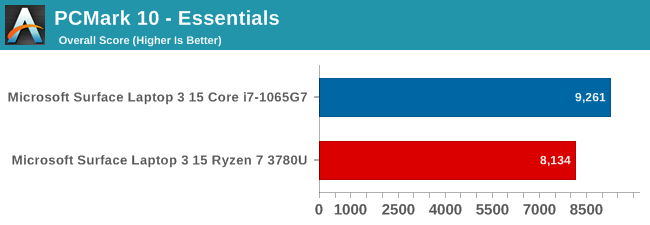

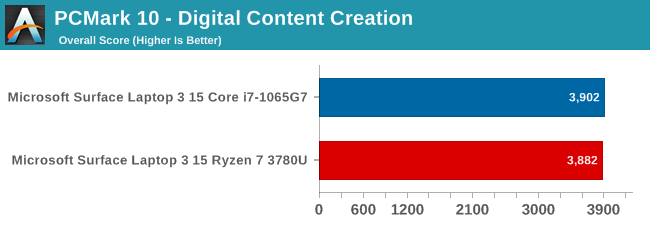
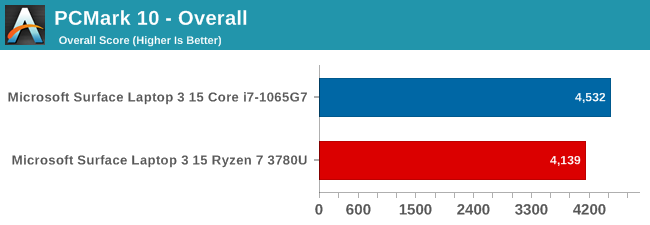
PCMark 10 consists of several real-world tests, including web, video conferencing, spreadsheets, writing, and more. There are several GPU tests as well, including rendering, and some gaming. The suite also measures application start-up, and all aspects of the system’s performance factor into the score.
Intel’s CPU performance lead shows clearly here again, with significant leads in both the Essentials and Productivity tests, although AMD’s strong GPU pulls the Ryzen system very close on the Digital Content Creation tasks. But that is not enough to turn the tide, and the Ice Lake platform carries this win.
Cinebench R20
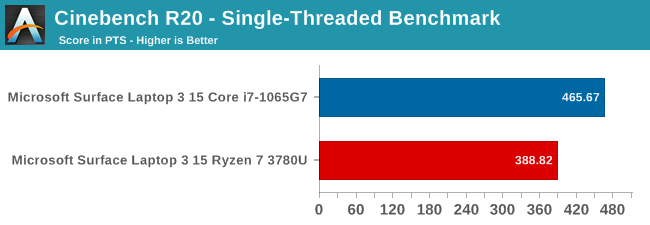
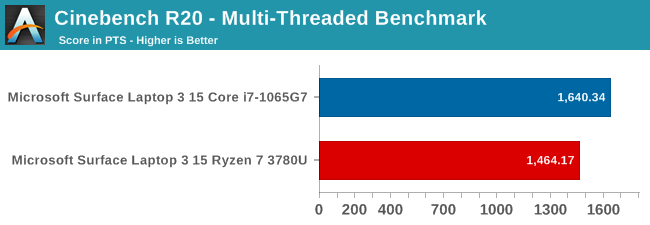
Looking at the latest version of Cinebench tells a similar story as to what we’ve seen so far. Ice Lake’s significant IPC lead pulls it way ahead. On the multi-threaded test, the AMD platform does close the gap somewhat, which is similar to the SPEC rate 8 results.
7-Zip
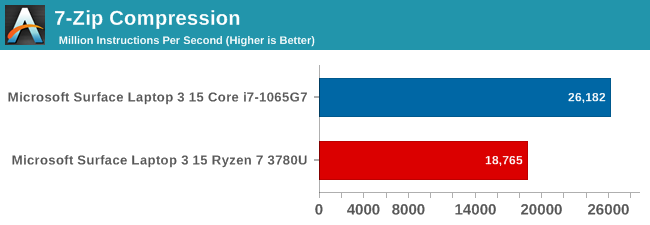
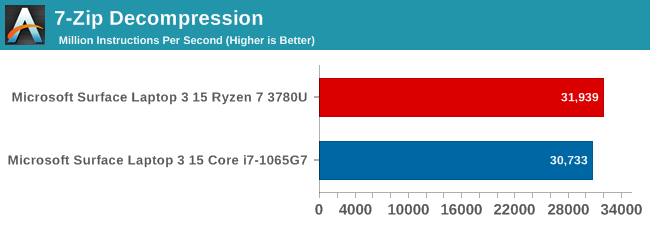
Checking out the popular 7-Zip file compression tool, the results are in-line with what we see in the desktop space. Intel generally has a lead on the compression side, but AMD claws back at decompression. It is a rare win on the CPU side for AMD here.
Handbrake
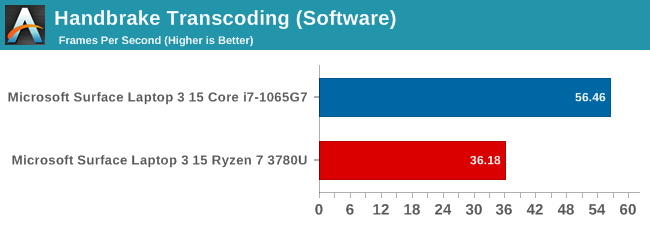
Transcoding is a popular task, and Handbrake is one of the most popular tools. For this test, a 1080p movie is converted to 720p using the x264 encoder. Once again, Ice Lake offers significantly more performance when transcoding in software.

Handbrake also supports various hardware encoders, such as Intel’s QuickSync, which provides significantly quicker transcodes at the same settings – albeit at larger file sizes and slightly lower quality compared to the software transcode, according to the Handbrake documentation. QuickSync has been very popular, and has been around quite a while. AMD also offers hardware encoding and decoding with their Video Core Next platform. Handbrake does support AMD’s Video Coding Engine (VCE) but the Surface Laptop 3 does not offer this as an option in Handbrake, so it was not able to be tested. As this is the only current Ryzen mobile APU we’ve tested, it may be a driver issue specific to the Surface branded processor.
x264
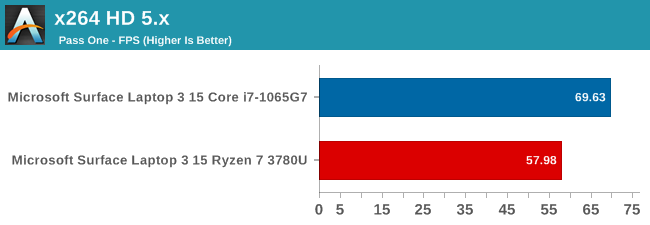
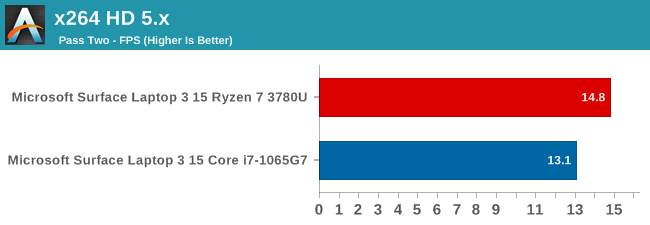
Our previous transcoding test, x264, was also run. Here we see that once again Ice Lake has a significant performance advantage, as it did with Handbrake software encoding.
Web Tests
All of our web tests were run with the current version of Microsoft Edge in Windows 10 1909. Web results are highly impacted by the underlying scripting engine, and Microsoft is going to be moving Edge from the EdgeHTML rendering engine to the Chromium open-source project that powers Google Chrome. When they make this change, expected early in 2020, we’ll revamp our suite with new tests.
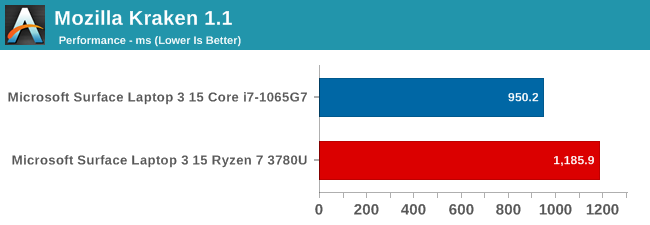

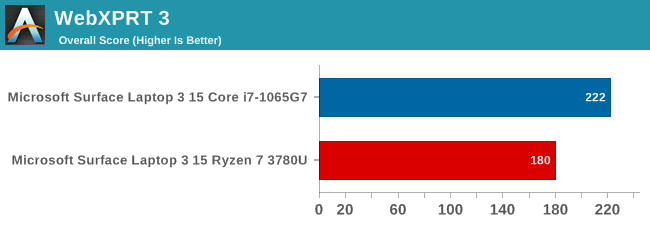
Intel has aggressively pushed their frequency ramping with Speed Shift, and one of the biggest beneficiaries of Speed Shift is web scripting, since the tasks tend to be very short. AMD is addressing this in Zen 2 with Collaborative Power Performance Control 2, or CPPC2, which is not as elegant of a name as Speed Shift, but promises to drop Zen’s frequency ramping from ~30 ms to ~1 to 2 ms, and will be a welcome addition on our web tests.










174 Comments
View All Comments
serendip - Saturday, December 14, 2019 - link
The pricing borders on the ridiculous for the AMD version of the SL3, on top of the Ice Lake variant not being available for consumers. I'm all for competition in the mobile chip arena but Ryzen Picasso is uncompetitive at $2000. Microsoft really made a mess this time. But then again, the 15" SL3 is a niche of a niche product, so they could be using this as an experiment for AMD on the next Surface Pro.MBarton - Monday, December 30, 2019 - link
The only reason Microsoft is using leftover Zen Picasso parts is because Intel's 10nm is so pathetic that they can't get enough working Intel parts to supply demand. So Microsoft got a cheap deal on old Zen+ parts to help fill the void. Low margin mobile CPU markets are not what AMD is focused on. AMD needs money and the profits are in the server market and HEDT market.Jhlot - Sunday, December 15, 2019 - link
"On purely CPU based tasks, Ice Lake really stretched its legs, and despite this being a 3.9 GHz chip, in single-threaded SPEC 2017, it managed to come very close to a 5.0 GHz Core i9-9900K with a massively higher TDP.Sunny Cove cores on Desktop are going to very good if Intel can get the darn things out.
eastcoast_pete - Sunday, December 15, 2019 - link
Maybe somebody at AT or here knows, but my favorite suspicion why MS even had a Ryzen mobile system on offer despite it being a full generation behind is that they didn't trust Intel getting their 10 nm Ice Lake fabbing straightened out in time, and didn't want to risk getting caught without pants. In other words, was this MS playing it safe with the AMD APU as second option just in case Intel came up short again? What's the word?heffeque - Sunday, December 15, 2019 - link
This sounds very plausible.MBarton - Monday, December 30, 2019 - link
Intel HASN'T gotten their 10nm Ice Lake "straightened out". Hence why Intel is suddenly mum on Ice Lake server parts. They've totally disappeared from presentations. Why anybody thought that Intel would get ICL "straightened out" now, out of the blue, is beyond me. 10nm is essentially dead.AntonErtl - Sunday, December 15, 2019 - link
As long as the Ryzen U chips don't get competetive idle power consumption, they will have a severe handicap in the laptop market. But for small fanless barebones systems (e.g., something like the Zotac ZBOX CI series), they should be quite appropriate. I wonder why we don't see them in that capacity.Farfolomew - Sunday, December 15, 2019 - link
10th Gen Comet Lake CPUs are better than Ryzen 3k APUs. Of course Ice Lake is going to dominate. Zen 3 better be decent to compete with Icelake on desktop.scineram - Monday, December 16, 2019 - link
What Icelake on desktop?maroon1 - Tuesday, December 17, 2019 - link
We won't see icelake on desktop even next year